The Fall Bright Tavern, and a defense of the imperfect restaurant.
Adapted from: the pursuit of culinary excellence.
Perfection is a trap, an illusion that blinds us to the charms of those who come up short. This might be the kind of take you’d expect from the contrarian daughter of exacting Chinese academics, but I stand by it. The immaculate is easy to ignore. There’s nothing for your heart to catch on. Think about precise geometric patterns, perfectly symmetrical people, Kim Kardashian’s house—beautiful, yes. Boring, too.
My favourite restaurant genre is The Place Next Door. These restaurants have never gone viral or been visited by the tire man. There’s no star chef in the kitchen, no Architectural Digest feature on YouTube, no adoring press exalting their culinary ingenuity. These are not my requisites for the genre as much as the reality of a culture that overlooks such places, an industry that reveres mastery, innovation, and prestige and gives little fanfare to the restaurants that are just here to do their unsexy jobs well.
The job description is simple: be a place where I can eat a great meal with people I love without having to plan for it three months out. Where I do not need a special occasion, or: the special occasion is being alive and sentient on this rock hurtling through space, and that’s enough. Where the price point reflects a fair1 exchange for your ingredients, time, effort, expertise, and the margin you need to keep doing this. Where I, sitting down and taking a bite, do not regret having chosen your cooking over mine.
Many restaurants fit this description—some of them even excel at the job—but will never get their flowers because their approachability is used as a mark against them. Their linen is mismatched, their service spotty, their presentation homey. The vibes, as the parlance goes, are not immaculate. These are the imperfect restaurants I love.
The Fall Bright Tavern, on a Wednesday in December.
We’d looked for a reservation on a Sunday for the following Wednesday. Not an issue. We walked over that night from a climbing lesson, and N. opted to stay in her workout clothes. Also not an issue.
I’ll always prefer restaurants with enough range and elasticity (in ambiance, offering, formality) to conform to you over those that set a standard you feel obliged to meet. The Fall Bright Tavern does this beautifully, and by design. When they first opened—around this time last year—the restaurant declared itself a “Pop & Pop” shop, a nod to co-owners and partners Joe Rutherford and Brett Healey. Both are trained sommeliers; Healey is back in the kitchen at Fall Bright after working front of house at Edulis. The warming, welcoming casualness of the space—which used to house my beloved Little Sito—is very much the point. It’s all warm bulbs, exposed brick, and the low licks of candlelight.
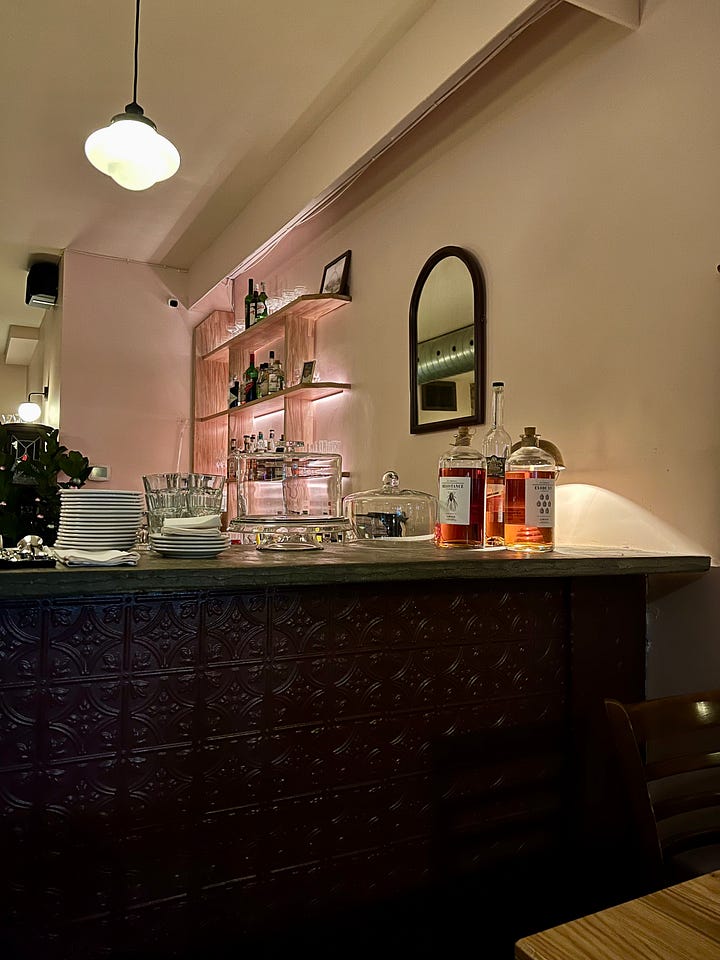
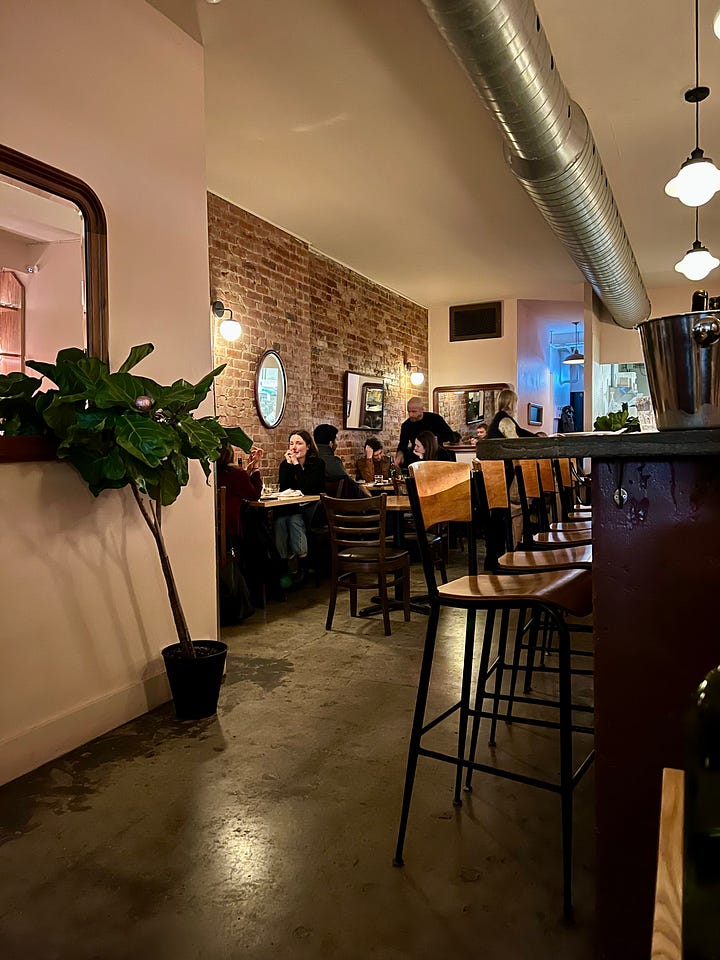
The menu changes often, following the ebbs and flows of seasonal produce. Having now been a handful of times, I’ve only seen the same dish twice—always some version of a braised beef cheek. The menu mostly spans from gourmet snacks to elegant comfort food, always leaving a few thoughtful slots for those who can’t eat a meal without a vegetable.
Responsible eaters that we are, N. and I started with a salad. It’s a tightrope act—earthy lentils countered by bright preserved pears and onions steeped in red wine. It would have been a great salad, flavours tailored for the season with lettuce as the vehicle, except for a few gritty bites of lentil. I am inclined to dismiss it because my bar for salad is on the floor, but you may find this unforgivable.
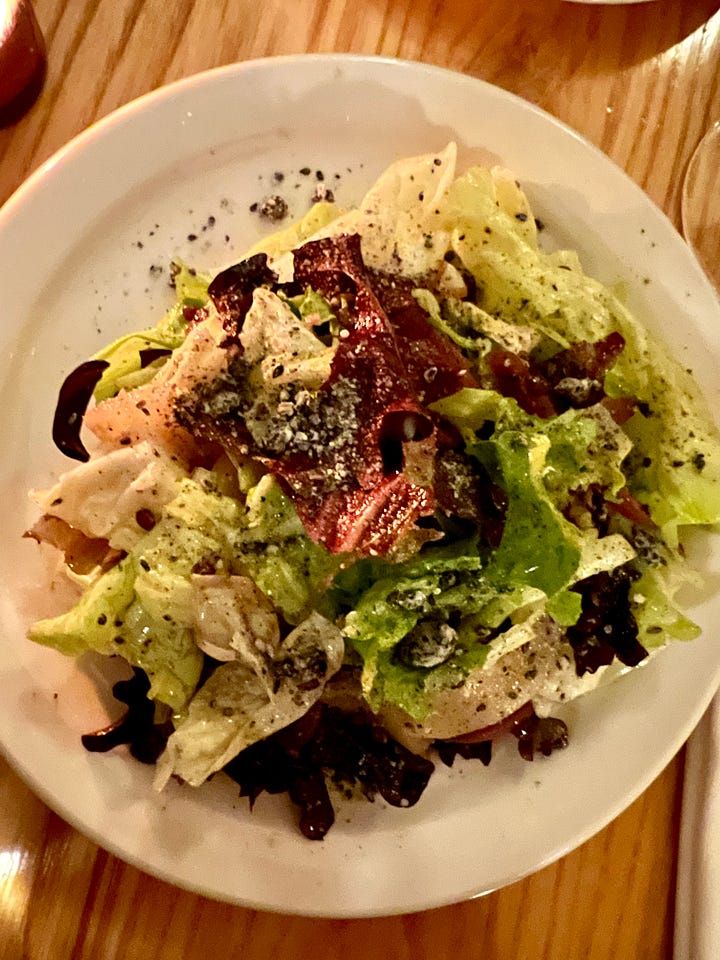

Having met our minimum daily intake of greenery, we turned our attention to the beige dish. The croquettes are unapologetically oozy, filled with melted cheese and onions, served with a tarragon ranch dip. (I welcome the word ranch on a menu. I love a chef who doesn’t take themselves too seriously.) Its fried, allium-forward palate summons the memory of one of my favourite elementary school snacks: instant noodles crumbled right in its bag and topped with flavour dust. Which is to say: the dish is junky in a conspiratorial way, pleading with pleasure to set aside the guilt for once. At this point, I have already forgotten about the lentils.
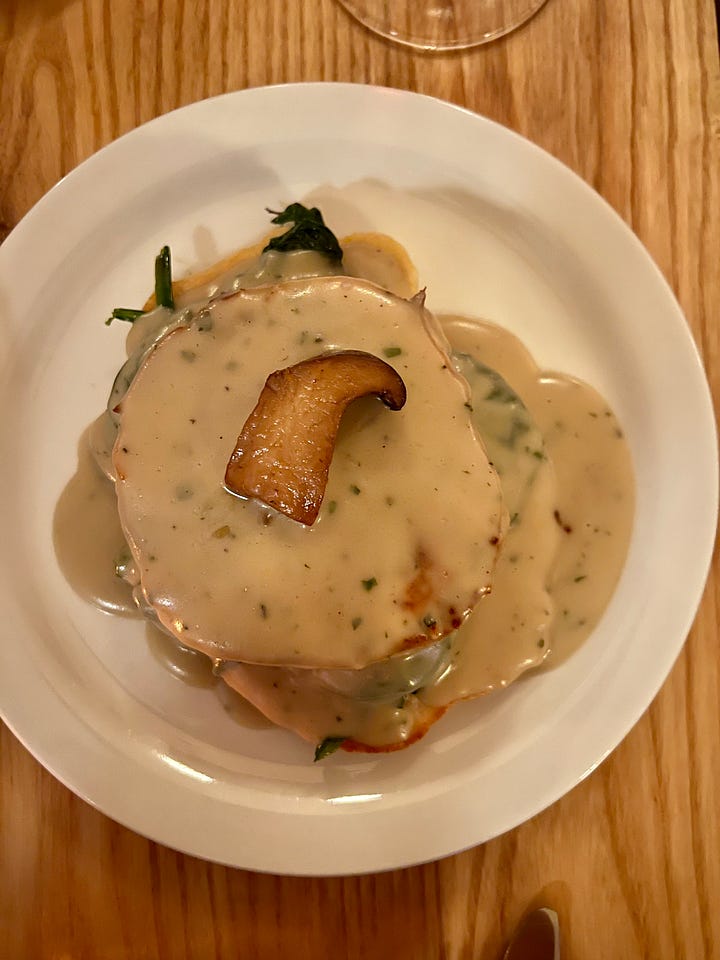

The mains and desserts are what I would go to the Fall Bright for. They’re rich without teetering into too-much, the kind of comfort food that borrows from nostalgia but doesn’t lean on its excesses as a crutch. We opted for the chicken sausage dish—a sausage patty and a dense and tart sourdough pancake buffered by wilted spinach, the whole thing blanketed in a lovely mushroom cream sauce—and the pork meatballs, which comingle with shrimp and a spicy, tomatoey lobster gravy on a bed of grits. The former is a mild hum of flavour, the latter a thunderclap. Toggling between them felt strangely difficult on the palate, like switching tabs on an overheated laptop. It’s the cost of sharing to sample as much as you can.
At one point in the night, I asked Healey about the large bottles on the counter, so comically large they could have been mistaken for decoration. They’re absolutely drinkable, he explained, and generously brought over a couple of glasses to the table. It’s a bottle of Laballe Exode XIV Armagnac, a new-to-me type of brandy from the eponymous region of southwest France. It smells like a hangover and tastes surprisingly smooth, a mouthful of dried fruit, almonds and beeswax.

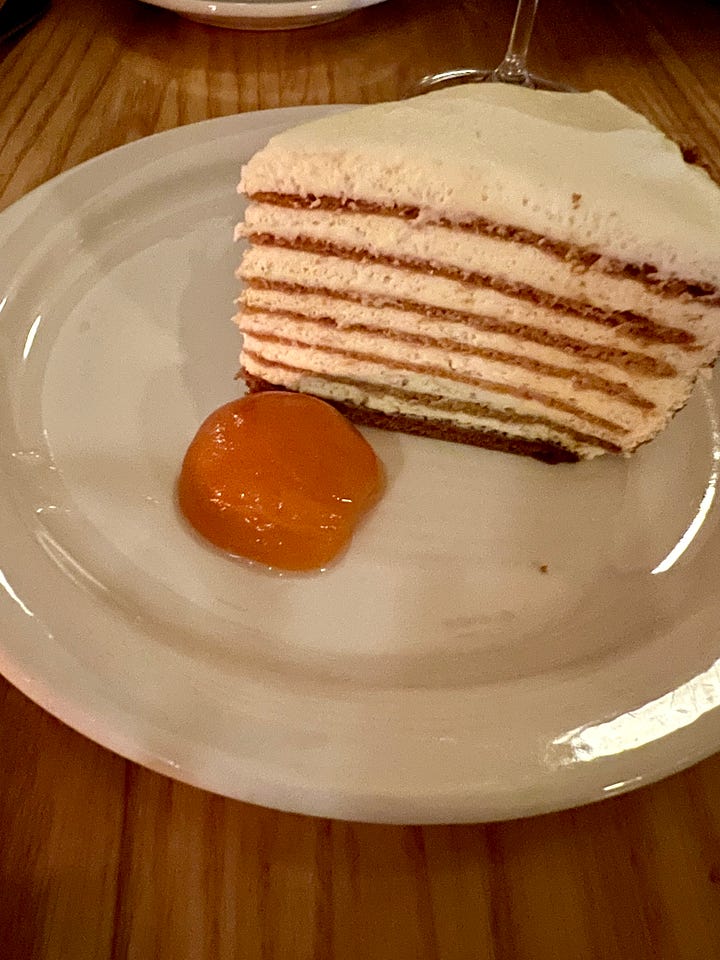
With honey on our minds, we ordered a dessert to share: a Ukrainian-style honey cake with a preserved apricot. It’s a textural delight—thin layers of honey pancakes alternating with fluffy sour cream. What density it risks in the number of layers, it makes up for in airiness; what may have approached the saccharine is held back by the tartness of sour cream. This push-pull is what brings me back to Fall Bright, a calibrating equilibrium I’ve tasted in every dish.
It was N.’s first time eating there, so I asked for her take. She agreed that it was a very good, no-fuss meal, but balked at my rating of the restaurant, which I’d casually described as “a solid 7.5 every time.” I don’t believe in rating restaurants this way, but thought it a useful shorthand for conveying this idea of the imperfectly-good restaurant. We have noticed throughout our friendship that we have different approaches to ratings. For her, imperfectly-good starts in the middle, Japanese-style. I rate, as our friend A. astutely pointed out, like an academic: at 5/10, you’ve failed.
Reviews, too, operate in the sphere of the imperfect, their subjectivity masked by the veneer of objective metrics. We’ve learned to distrust the disproportionate number of positive reviews out there and now assign an outsized value and level of authenticity to the negative. Experts are accused of having their noses in the air; everyday reviewers are looked down on for their lack of knowledge. What is the role of criticism in the era of social proof? Do we need another take polluting this ocean of takes?
I don’t pretend to be exempt from these biases or have the answers. What motivates me to write, at least in the world of food, is this feeling that the middle remains unexplored and underserved. I’m curious about that space between expert and amateur, both in restaurants and the people who get to write about them. The imperfectly good. The ones trying to do an unsexy job to the best of their ability.
The Fall Bright Tavern
840 Bloor St W.
Toronto
Fairness is, of course, wildly subjective; at the very least, not disrespectful.

